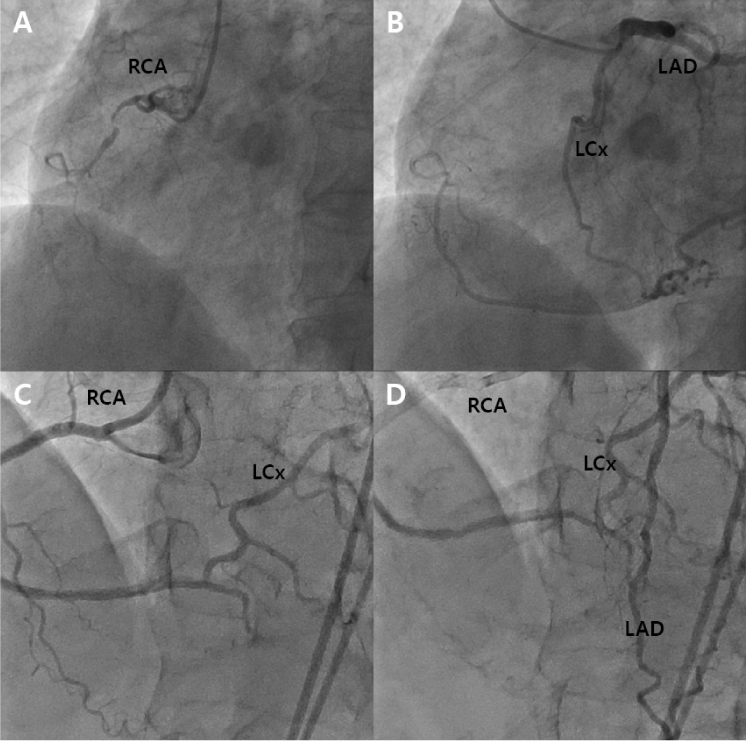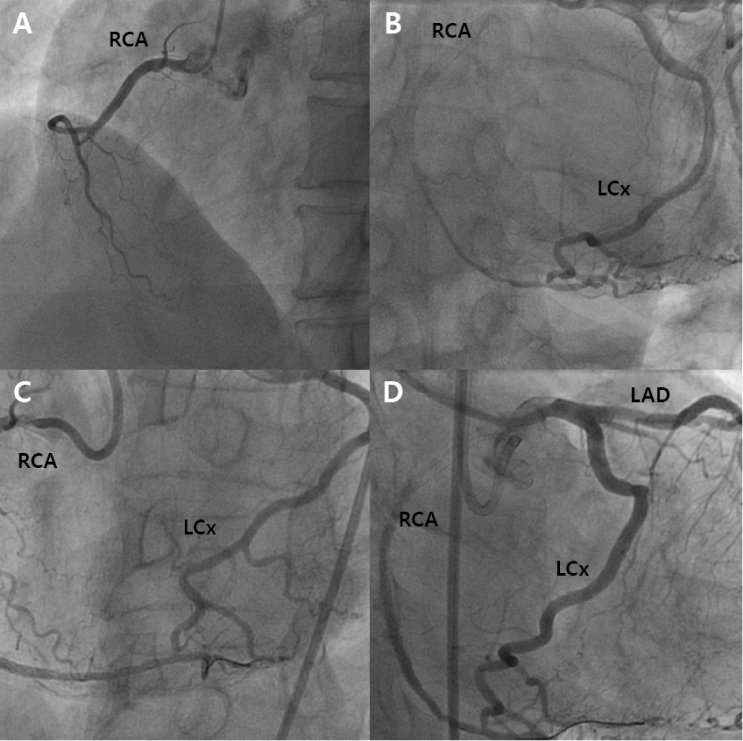J Lipid Atheroscler.
2012 Dec;1(2):105-109. 10.12997/jla.2012.1.2.105.
Protective Role of Intercoronary Communication between Right Coronary Artery with Chronic Total Occlusion and Normal Left Circumflex Artery against Recurrent Myocardial Ischemia
- Affiliations
-
- 1Division of Cardiology, Department of Internal Medicine, Yonsei University College of Medicine, Seoul, Korea. CBY6908@yuhs.ac
- KMID: 2198369
- DOI: http://doi.org/10.12997/jla.2012.1.2.105
Abstract
- Intercoronary communication is a very rare congenital malformation, which differs from coronary collaterals in variable aspects. It is larger in diameter, extramural in location and more resembles normal mature arterial features histologically. There are no consensus for the definition of intercoronary communiations, but some reports have suggested their protective role against myocardial ischemia due to its dual blood supply system. We report the case of a 72 year-old male smoker who had chronic total occlusion at the proximal portion of right coronary artery, which was communicated with a normal left circumflex artery. Although the patient had chronic total occlusion and subsequent in stent restenosis, there were no presentations of acute coronary syndrome or myocardial infarction.
MeSH Terms
Figure
Reference
-
1. Yamanaka O, Hobbs RE. Coronary artery anomalies in 126,595 patients undergoing coronary arteriography. Cathet Cardiovasc Diagn. 1990; 21:28–40.
Article2. von Kodolitsch Y, Franzen O, Lund GK, Koschyk DH, Ito WD, Meinertz T. Coronary artery anomalies Part II: recent insights from clinical investigations. Z Kardiol. 2005; 94:1–13.3. Burri M, Bopp P. [Congenital intercoronary arterial anastomosis. Apropos of a case and review of the literature]. Arch Mal Coeur Vaiss. 1986; 79:1962–1964.4. Voci G, Patel RB, Trivedi AD, Patel PV, Burris AC, Ruby SR. Angiographic demonstration of congenital intercoronary communication in normal adults. Am J Cardiol. 1987; 59:1205–1206.
Article5. Gur M, Yilmaz R, Demirbag R. Unidirectional communication between the circumflex and right coronary arteries: a very rare coronary anomaly and cause of ischemia. Int J Cardiovasc Imaging. 2006; 22:339–342.
Article6. Reig J, Jornet A, Petit M. Direct connection between the coronary arteries in the human heart. Intercoronary arterial continuity. Angiology. 1995; 46:235–242.
Article7. Koerselman J, van der Graaf Y, de Jaegere PP, Grobbee DE. Coronary collaterals: an important and under-exposed aspect of coronary artery disease. Circulation. 2003; 107:2507–2511.8. Esente P, Gensini GG, Giambartolomei A, Bernstein D. Bidirectional blood flow in angiographically normal coronary arteries. Am J Cardiol. 1983; 51:1237–1238.
Article9. Gavrielatos G, Letsas KP, Pappas LK, Markou V, Antonellis J, Tavernarakis A, Kardaras F. Open ended circulation pattern: a rare case of a protective coronary artery variation and review of the literature. Int J Cardiol. 2006; 112:e63–e65.
Article10. Linsenmeyer GJ 3rd, Schneider JF. Angiographically visible intercoronary collateral circulation in the absence of obstructive coronary artery disease. Am J Cardiol. 1984; 53:954–956.
Article
- Full Text Links
- Actions
-
Cited
- CITED
-
- Close
- Share
- Similar articles
-
- Right Ventricular Myocardial Infarction due to Right Coronary Artery Total Occlusion Originating From the Distal Left Circumflex Artery
- Intercoronary Communication between the Circumflex and Right Coronary Arteries Coexisted with Coronary Vasospasm
- Congenital Absence of Left Circumflex Coronary Artery: Circumflex Artery Extended from Right Coronary Artery
- A Single Coronary Artery: Right Coronary Artery Originating From the Distal Left Circumflex Artery
- 2 Case of Coronary Artery-to-Left Ventricular Fistulae



